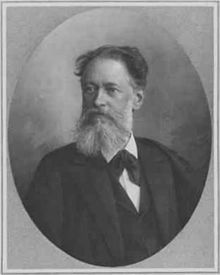Johann Nepomuk Prix
Johann Nepomuk Prix (born May 6, 1836 in Vienna ; † February 25, 1894 in Rekawinkel , Lower Austria ) was an Austrian local politician and mayor of Vienna.
Prix studied law at the University of Vienna from 1854 to 1858 and was awarded a Dr. jur. doctorate and was then court and court advocate. From 1869 he was a mandate in the Vienna City Council (member of the Liberal Progress Club) and from 1882 1st Deputy Mayor, who from 1883 had his seat in the newly opened Vienna City Hall . From 1885 until his death he was also a member of the Lower Austrian state parliament . On November 28, 1889, he was elected Mayor of Vienna on December 7, 1889 with an imperial license to practice medicine.
In December 1889, under Prix, the line wall as a tax border to the 43 suburbs of the city on the right bank of the Danube was lifted. This was the first step towards their incorporation, which was decided in 1890 and came into effect administratively on January 1, 1892 (start of operation of the magistrate district offices ): Districts 1–10 were added to districts 11–19, which are largely very populous. The city of Vienna had thus grown significantly. Prix therefore had municipal council elections held for the first time in 1891, in which the men of the new districts who were then eligible to vote were also eligible to vote; universal, equal suffrage for both sexes was still almost 30 years away.
In 1893, at Prix's instigation, a building zone plan was decided and the building regulations were amended. Politically, Prix came into strong political opposition to the opposition led by Karl Lueger and resigned in October 1893 after criticizing financial transactions that the local council had not decided. He was re-elected a few days later, but died of a heart attack three months after these events while on an excursion.
During Prix's term of office as mayor, Vienna found itself in a stormy urban development: the imperial court had the two monumental court museums built on Maria-Theresien-Platz , which opened in 1889 and 1891. In 1892/1893, in a cooperation between the state , the state of Lower Austria and the city of Vienna, the construction of the city railway , which was to change the cityscape significantly, especially on the structural engineering lines, and the regulation and arching of the Vienna River . A few days after Prix's unexpected death, the agreed demolition of the line wall , the city's former tax border with the suburbs, began. The belt road between the old and the new districts was completed and expanded in the western part.
His grave of honor is in the Vienna Central Cemetery (group 14 A, number 55). 1960 in Kagran (had not heard the Prix to 'lifetime to Vienna) in the 22nd district near the Old Danube , the Prix alley named after the mayor.
literature
- H. Wohlrab: Prix Johann Nep .. In: Austrian Biographical Lexicon 1815-1950 (ÖBL). Volume 8, Verlag der Österreichischen Akademie der Wissenschaften, Vienna 1983, ISBN 3-7001-0187-2 , p. 287.
Web links
- Entry on Johann Nepomuk Prix in the Austria Forum (in the AEIOU Austria Lexicon )
| personal data | |
|---|---|
| SURNAME | Prix, Johann Nepomuk |
| BRIEF DESCRIPTION | Austrian politician, mayor of Vienna, member of the state parliament |
| DATE OF BIRTH | May 6, 1836 |
| PLACE OF BIRTH | Vienna |
| DATE OF DEATH | February 25, 1894 |
| Place of death | Rekawinkel |



